Provincial museums of Canada
Provincial museums of Canada are museums maintained by the provinces of Canada to preserve their local history and culture. However, the collections of some museums extend beyond its provincial boundaries, showcasing historical and natural works from around the world. Provincial museums are the equivalent to national museums, operated by the provincial governments of Canada. In the mostly French-speaking province of Quebec, the provincial government uses the term "national" to refer to provincial museums.
Many provinces have separate facilities for human and natural history museums, art galleries, and archives. However, in the case of Newfoundland and Labrador, all these functions are housed in one complex, The Rooms, in St. John's
List of provincial museums
Nearly all Canadian provinces operate a provincial museum of some kind. The only province that does not operate a provincial museum is Prince Edward Island. The following table lists the nine provincial museums presently operating in Canada.
| Name | Photo | City | Province | Year established | Visitors annually | Description |
|---|---|---|---|---|---|---|
| Manitoba Museum | Winnipeg | 1965 | 303,191 (2017)[1] | A museum of human and natural history. | ||
| Musée de la civilisation | Quebec City | 1984 | 543,128 (2005) | A museum of human history. | ||
| New Brunswick Museum |  |
Saint John | 1842 | 32,584 (2017)[2] | A museum of human and natural history, it is the oldest continuously operating museum in Canada. | |
| Nova Scotia Museum | Multiple sites | 1868[note 1] | 549,500 (2015)[note 2][3] | The museum is a decentralized museum system made up of 28 museums spread throughout the province. | ||
| Royal Alberta Museum | 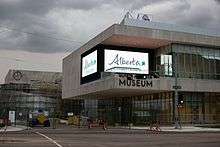 |
Edmonton | 1967 | A museum of human and natural history. | ||
| Royal British Columbia Museum | 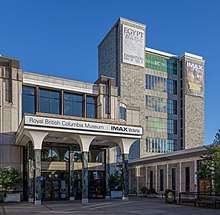 |
Victoria | 1886 | 770,000 (2017)[4] | A museum of human and natural history, it also houses the provincial archives, after merging with British Columbia Archives in 2003. | |
| Royal Ontario Museum | .jpg) |
Toronto | 1912 | 1,440,000 (2017)[5] | A museum of art, human and natural history, it is the largest, and most visited museum in Canada. | |
| Royal Saskatchewan Museum | .jpg) |
Regina | 1906 | 139,122 (2017)[6] | A museum of natural history. | |
| The Rooms | %2C_St._John's%2C_Newfoundland%2C_Canada.jpg) |
St. John's | 2005 | 87,083 (2017)[7] | A museum of human and natural history, the museum shares a building with the provincial archives and art gallery. |
List of provincial art galleries
Six Canadian provinces operate a provincial art gallery. The following table lists the six provincial art galleries presently operating in Canada.
| Name | Photo | City | Province | Year established | Visitors annually | Description |
|---|---|---|---|---|---|---|
| Art Gallery of Alberta | .jpg) |
Edmonton | 1924 | 151,458 (2016)[8] | Its collection includes historical and contemporary paintings, sculptures, installation works, and photographs from Canadian and international artists. | |
| Art Gallery of Nova Scotia | Halifax | 1908 | 45,455 (2017)[9] | The largest art gallery in Atlantic Canada, its collection includes classical portraits, Nova Scotia folk art, and Inuit stone carvings. | ||
| Art Gallery of Ontario | 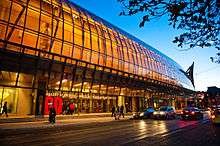 |
Toronto | 1900 | 718,200 (2016)[10] | The art gallery is the largest provincially-managed art gallery in the country. Its collection includes 90,000 works ranging from the first century to present day, as well as the largest collection of Canadian art. | |
| Beaverbrook Art Gallery | 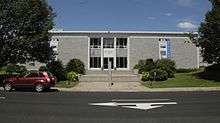 |
Fredericton | 1959 | 10,333 (2016)[11] | Designated as a provincial art gallery by Government of New Brunswick, the gallery was originally funded by Baron Beaverbrook. | |
| Musée national des beaux-arts du Québec | 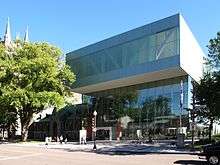 |
Quebec City | 1933 | 324,312 (2012)[12] | Its collection includes approximately 25,000 works produced in Quebec, or by Quebec artists since the 18th century. | |
| The Rooms | %2C_St._John's%2C_Newfoundland%2C_Canada.jpg) |
St. John's | 2005 | 87,083 (2017)[7] | The provincial art gallery shares a building with the province's provincial archives, and museum. |
List of provincial archives and libraries
Nearly all Canadian provinces operate a provincial archive and libraries. The British Columbia Archives was a former provincial agency that managed the archives for the province of British Columbia. In 2003, the provincial government merged the British Columbia Archives with the Royal British Columbia Museum, while the record management component of the former agency was assumed by the British Columbia Ministry of Labour and Citizens' Services.[13] Since 2003, the Royal British Columbia Museum maintains the provincial archives as a department of the museum.[14]
The following table lists the nine provincial archives and libraries presently operating in Canada.
See also
Notes
- ↑ Although the Nova Scotia Museum was established in 1868, the decentralized museum includes institutions that were established earlier, such as the Halifax Mechanics Institute in 1831.
- ↑ The following is the total attendance figure from all 28 Nova Scotia Museum locations.
- ↑ The provincial archives of Quebec operates 10 facilities spread throughout the province of Quebec. However, the Grande Bibliothèque in Montreal is its flagship library.
- ↑ In addition to its Regina location, the Provincial Archives of Saskatchewan operates a regional office in Saskatoon.
References
- ↑ "Annual Report". The Manitoba Museum. 2018. Retrieved 17 August 2018.
- ↑ "2017 Tourism Indicators" (PDF). New Brunswick Department of Tourism, Heritage and Culture. 2018. p. 4. Retrieved 17 August 2018.
- ↑ "Nova Scotia Museum Attendance (by region) 2006–2015" (PDF). Nova Scotia Museums. 2016. Retrieved 21 August 2018.
- ↑ "Goals, Strategies, Measures and Targets" (PDF). Royal BC Museum 2016/17 Annual Service Plan Report. Royal British Columbia Museum. 2017. p. 9. Retrieved 25 August 2018.
- ↑ "The Royal Ontario Museum Draws Highest Attendance Numbers in its History". Royal Ontario Museum. 2 May 2018. Retrieved 17 August 2018.
- ↑ "Royal Saskatchewan Museum Director Report" (PDF). Friends of the Royal Saskatchewan Museum Inc.: 2016-2017 Annual Report. Royal Saskatchewan Museum. 2017. p. 5. Retrieved 17 August 2018.
- 1 2 "A message from the Chiar of the Board of Directors" (PDF). The Rooms Annual Report 2016–2017. Newfoundland and Labrador Department of Tourism, Culture, Industry and Innovation. 2017. Retrieved 17 August 2018.
- ↑ "Message from the Chair" (PDF). Report to the Community 2016. Art Gallery of Alberta. 2017. p. 4. Retrieved 17 August 2018.
- ↑ "Performance Scorecard 2016-2017" (PDF). Art Gallery of Nova Scotia Annual Accountability Report for the Fiscal Year 2016-2017. Art Gallery of Nova Scotia. 2017. p. 10. Retrieved 17 August 2018.
- ↑ Coull, Caitlin (2016). "AGO concludes 2015/2016 fiscal year with solid attendance, remarkable collection growth and a healthy operating position". Art Gallery of Ontario. Retrieved 17 August 2018.
- ↑ "Gallery Attendance" (PDF). Beaverbrook Art Gallery Annual Report 2016. Beaverbrook Art Gallery. 2016. p. 26. Retrieved 17 August 2018.
- ↑ "Rapport annuel 2011-2012". Musée national des beaux-arts du Québec. Retrieved 28 May 2013. (in French)
- ↑ "History of the British Columbia Archives" (PDF). Royal British Columbia Museum. June 2018. Retrieved 21 August 2018.
- ↑ "David Alexander: Head of Archives, Access and Digital". Royal British Columbia Museum. 2018. Retrieved 21 August 2018.
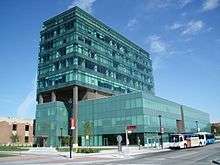
.jpg)